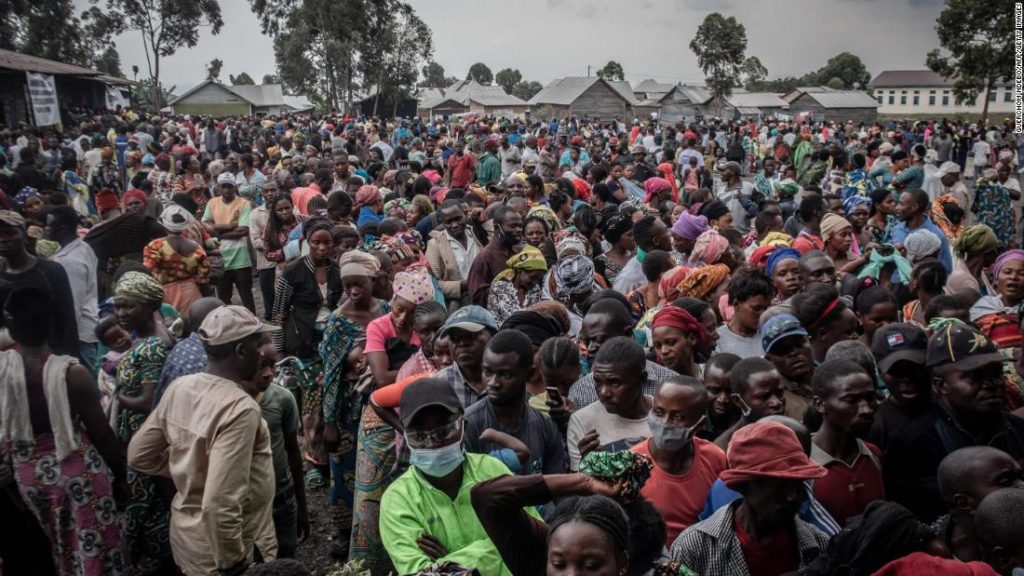Maj. Njike Kaiko Guillaume, spokesperson for the military governor of North Kivu, said that the Volcanic Observatory of Goma had identified magma under the city that also extends under Lake Kivu. While that magma has partially drained, radar images indicate that the crater inside the summit of the volcano continues to expand, he reported.
“On the basis of this information, we still can’t exclude a ground eruption or an eruption under the lake — but one could come with very little or no warning,” the spokesperson said.
Since then, the area has experienced a series of earthquakes and tremors, some felt as far away as the Rwandan capital of Kigali, 65 miles from the volcano in the Virunga National Park.
Ten neighborhoods in the “red zone” area of the city of Goma are now being evacuated due to risks, with significant cracks in the ground — some stretching the entire width of the road, others in the walls of buildings — already visible. Around 80,000 households have been evacuated so far, the spokesperson said.
One resident told CNN on Thursday that some of his neighbors in high-rise buildings have fled their homes out of fear that they might collapse.
Many of those fleeing have traveled on foot, carrying mattresses and cooking utensils, the United Nations Children’s Emergency Fund (UNICEF) said Thursday.
The military spokesperson said that displaced people had been arriving at evacuation zones that would facilitate assistance from the government and humanitarian organizations.
Earlier Friday, UNICEF warned that up to 400,000 people, including nearly 280,000 children, could be displaced if the volcano erupts again.
“Whenever large groups of people are displaced in a short period of time, the dangers to children increase,” warned the UNICEF representative in the DRC, Edouard Beigbeder. “We must be alert to immediate risks for children on the move, including protection issues, nutrition and health risks, including waterborne disease and especially the spread of cholera.”
The UN agency added that nearly 700 of the 1,000 children that had been separated from their parents amid the chaos of Saturday’s eruption have now been identified, and that they were helping to reunite those children with their families.
The military governor also encouraged the provincial health and civil authorities to take charge of unaccompanied children on Friday.
Goma, the capital of North Kivu province, is situated at the edge of Lake Kivu on the DRC’s border with Rwanda. According to official projections from the UN, World Bank and others, the city is home to approximately 670,000 people — however a number of nongovernmental organizations in the region place the population closer to 1 million.
Multiple conflicts in the central African country forced 2 million people to flee their homes in 2020, while there is also an acute lack of international aid and diplomatic attention, according a new report from the NRC.
“DR Congo is one of the worst humanitarian crises of the 21st century,” said NRC Secretary General Jan Egeland in a statement.
“A lethal combination of spiraling violence, record hunger levels and total neglect has ignited a mega-crisis that warrants a mega-response. But instead, millions of families on the brink of the abyss seem to be forgotten by the outside world and are left shut off from any support lifeline,” Egeland added.
The DRC has more than 27 million people, including over 3 million children, who do not have enough food to feed themselves — a third of the country’s population — and more than 5 million people who are internally displaced, according to NRC.
CNN’s George Engels also contributed to this report.
You may also like
-
Afghanistan: Civilian casualties hit record high amid US withdrawal, UN says
-
How Taiwan is trying to defend against a cyber ‘World War III’
-
Pandemic travel news this week: Quarantine escapes and airplane disguises
-
Why would anyone trust Brexit Britain again?
-
Black fungus: A second crisis is killing survivors of India’s worst Covid wave

